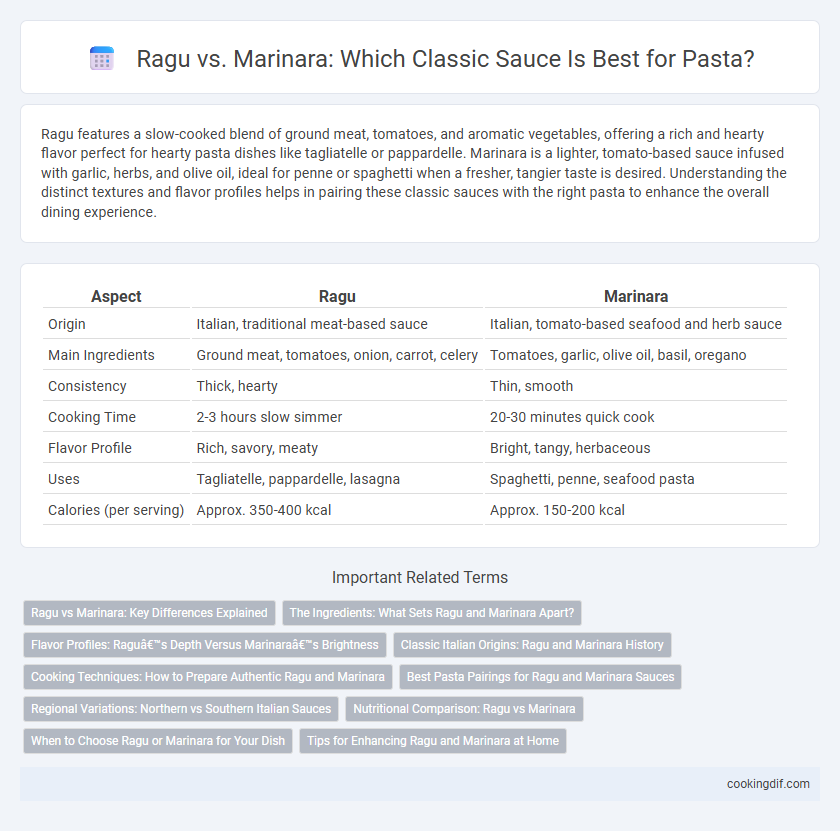Ragu features a slow-cooked blend of ground meat, tomatoes, and aromatic vegetables, offering a rich and hearty flavor perfect for hearty pasta dishes like tagliatelle or pappardelle. Marinara is a lighter, tomato-based sauce infused with garlic, herbs, and olive oil, ideal for penne or spaghetti when a fresher, tangier taste is desired. Understanding the distinct textures and flavor profiles helps in pairing these classic sauces with the right pasta to enhance the overall dining experience.
Table of Comparison
| Aspect | Ragu | Marinara |
|---|---|---|
| Origin | Italian, traditional meat-based sauce | Italian, tomato-based seafood and herb sauce |
| Main Ingredients | Ground meat, tomatoes, onion, carrot, celery | Tomatoes, garlic, olive oil, basil, oregano |
| Consistency | Thick, hearty | Thin, smooth |
| Cooking Time | 2-3 hours slow simmer | 20-30 minutes quick cook |
| Flavor Profile | Rich, savory, meaty | Bright, tangy, herbaceous |
| Uses | Tagliatelle, pappardelle, lasagna | Spaghetti, penne, seafood pasta |
| Calories (per serving) | Approx. 350-400 kcal | Approx. 150-200 kcal |
Ragu vs Marinara: Key Differences Explained
Ragu is a rich, slow-cooked Italian meat sauce typically made with ground beef, pork, or veal, simmered with tomatoes, wine, and aromatic vegetables; its thick texture and hearty flavor distinguish it from marinara. Marinara sauce is a lighter, faster-cooked tomato sauce made primarily from tomatoes, garlic, onions, and herbs, often used as a base or dipping sauce for pasta and seafood. The key differences lie in ragu's meat-based, complex preparation versus marinara's simple, vegetarian profile and quicker cooking time.
The Ingredients: What Sets Ragu and Marinara Apart?
Ragu features a rich combination of ground meat, soffritto (onions, carrots, celery), tomato paste, and red wine, emphasizing a slow-cooked depth of flavor. Marinara relies on fresh tomatoes, garlic, olive oil, and herbs like basil and oregano, creating a lighter, more vibrant sauce. The protein-heavy ragu contrasts with the vegetable- and herb-focused marinara, catering to different pasta pairings.
Flavor Profiles: Ragu’s Depth Versus Marinara’s Brightness
Ragu offers a rich, hearty flavor profile with slow-cooked meat, tomatoes, and aromatic vegetables creating deep, savory umami notes. Marinara features a bright, tangy taste from fresh tomatoes, garlic, and herbs, delivering a lighter, fresher sauce experience. The complexity of ragu complements robust pasta dishes, while marinara enhances lighter pasta with its vibrant acidity.
Classic Italian Origins: Ragu and Marinara History
Ragu, originating from Bologna in the Emilia-Romagna region, is a rich meat-based sauce traditionally slow-cooked with ingredients like beef, pork, tomato paste, and wine, embodying the heart of northern Italian cuisine. Marinara, with roots in southern Italy, particularly Naples, is a simple tomato-based sauce seasoned with garlic, onions, and herbs, famously served with seafood and pasta. Both sauces reflect regional ingredient availability and culinary traditions, highlighting Italy's diverse gastronomic heritage.
Cooking Techniques: How to Prepare Authentic Ragu and Marinara
Authentic ragu requires slow simmering of ground meat, tomatoes, onions, garlic, and herbs over low heat for several hours to develop deep, rich flavors and tender textures. Marinara sauce is prepared by quickly sauteing garlic and onions in olive oil before adding fresh tomatoes and simmering briefly to maintain a bright, fresh taste and vibrant color. Proper heat control and ingredient quality are essential in each technique to achieve the distinctive taste profiles of classic Italian ragu and marinara sauces.
Best Pasta Pairings for Ragu and Marinara Sauces
Ragu, rich and meaty, pairs perfectly with broad, textured pasta like pappardelle or tagliatelle that capture the thick sauce's hearty essence. Marinara, a lighter tomato-based sauce with garlic and herbs, complements thin, delicate pasta such as spaghetti or linguine, allowing the fresh, tangy flavors to shine. Both sauces bring unique characteristics that enhance pasta dishes when matched with the right noodle shapes and textures.
Regional Variations: Northern vs Southern Italian Sauces
Ragu is a hearty, meat-based sauce originating primarily from Northern Italy, especially Bologna, characterized by slow-cooked beef, pork, or veal with soffritto, tomatoes, and wine. Marinara, a lighter, tomato-based sauce with garlic, herbs, and olive oil, is a staple in Southern Italy, particularly Naples, reflecting the region's emphasis on fresh, simple ingredients. Northern Italian sauces like Ragu often feature richer, creamier textures and complex flavors, while Southern sauces like Marinara showcase bright, vibrant tomato taste and minimalist preparation.
Nutritional Comparison: Ragu vs Marinara
Ragu typically contains ground meat, providing higher protein and fat content compared to marinara, which is primarily tomato-based and lower in calories and fat. Marinara is rich in antioxidants like lycopene and vitamins A and C due to its vegetable ingredients, while ragu offers more iron and B vitamins from the meat. Choosing between ragu and marinara depends on dietary goals, with marinara being lighter and ragu offering a more nutrient-dense option.
When to Choose Ragu or Marinara for Your Dish
Choose ragu when seeking a rich, slow-cooked sauce infused with ground meat, tomatoes, and aromatic vegetables, ideal for hearty dishes like tagliatelle or pappardelle. Marinara suits lighter, quicker meals that highlight fresh tomato flavors, perfect for spaghetti or as a base for seafood pasta. The choice depends on cooking time, desired texture, and complementary ingredients to match your pasta dish perfectly.
Tips for Enhancing Ragu and Marinara at Home
Enhance ragu by simmering it low and slow to deepen the rich, meaty flavors, incorporating finely diced soffritto--onions, carrots, and celery--for natural sweetness and complexity. Boost marinara with fresh, high-quality Roma tomatoes and a hint of crushed red pepper, balancing acidity with a touch of sugar and finishing with fresh basil to elevate its bright, herbaceous notes. Using homemade stock or reserved pasta water can add body and cohesion to both sauces, ensuring a luscious texture that clings perfectly to your pasta.
Ragu vs Marinara for classic sauces Infographic

 cookingdif.com
cookingdif.com